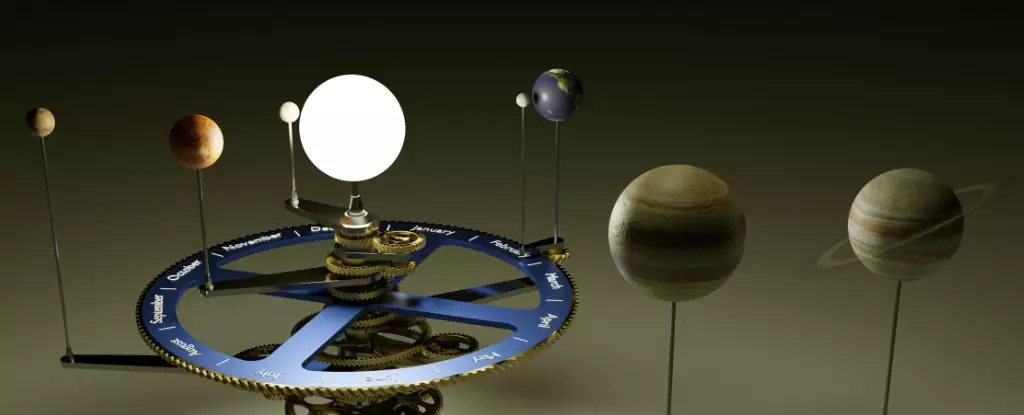As we step into early March, an extraordinary celestial event unfolds above us—a remarkable opportunity to witness a rare dance involving several planets in our Solar System. This month marks a unique occasion for astronomy enthusiasts, as all five naked-eye planets, including a recently arrived Mercury, will be visible from various locations around the globe. Having each of these planetary bodies lining up in the night sky is a spectacle numerous skywatchers eagerly anticipate, though the absence of certain key figures has often dampened similar efforts in recent years.
Recently, Mercury has emerged from its solar conjunction on February 9, presenting itself in the western sky just after sundown. The elusive nature of Mercury makes this formation significant; spotting Mercury can be a challenging feat for even seasoned observers. For those who might find the planet hard to locate, guidance can be found in the dazzling brilliance of Venus, which acts as a reliable reference point. On February 25, Mercury will pass closely—just 1.5 degrees—north of Saturn, and a few days later, the crescent Moon will add to the intrigue when it occults Mercury on March 1 for observers over Hawaii and the Pacific.
This kind of playfulness among celestial bodies is not merely happenstance; it also serves as a reminder of the various stories embedded in our exploration of the night sky. The legend surrounding the astronomer Nicolaus Copernicus—who famously never glimpsed Mercury—embodies the lingering challenges embedded in human efforts to comprehend the cosmos.
As we look forward to March 8, expect Mercury to reach its greatest elongation, standing 18 degrees east of the Sun, shining at a magnitude of -0.35. This period presents a prime opportunity to capture Mercury’s half-illuminated form through a telescope as it measures only seven arcminutes across. The conjunction of the crescent Moon and Venus on March 2 allows for potentially stunning daytime observations, drawing on historical accounts like the clear midday visibility of Venus during Abraham Lincoln’s second inauguration in 1865.
The celestial race continues as both Venus and Mercury journey towards their inferior conjunctions around March 23 and 24. Although spotting Venus in the morning sky is challenging, keen observers in good conditions can attempt this endeavor with a little patience and timing.
Meanwhile, Mars holds its position high in the east, displaying a ruddy hue as it shines brightly in the constellation Gemini. Having recently reached opposition on January 16, Mars will enjoy visibility as the waxing gibbous Moon passes its way on March 9. NASA’s forthcoming ESCAPADE mission, aiming to explore the Martian environment, heightens interest in these celestial gatherings. The complexities of studying Mars are matched by the curious phenomena we observe regarding its relationship to other celestial bodies.
Following Mars, we notice the benevolent giant, Jupiter, climbing high in the southern sky within Taurus. On March 2, it will reach quadrature—90 degrees east of the Sun—allowing for intensified scrutiny of its moons. Interestingly, Danish astronomer Ole Rømer’s observations into the timing discrepancies of Jupiter’s moons led to groundbreaking advancements in our understanding of light and speed. These moments ignite curiosity and inspire amateur astronomers to look up and question: “What might I be missing?”
Now, as we glance towards Saturn, the dimming ringed planet shines at a fainter magnitude compared to others. Located low on the western horizon, it promotes an exploratory spirit as observers utilize binoculars in an effort to discern its position amidst the murk. With Saturn transitioning out of the forefront during late March, observers should seize the opportunity to mark its exit while simultaneously welcoming the return of Mercury and Venus to the dawn sky.
Completing the planetary exploration are Uranus and Neptune. While Uranus can be spotted relatively easily with binoculars in Taurus, Neptune presents a tougher challenge as it lingers in the low, turbulent horizon with the others. Each planet has its own fascinating history, reminding us that unique discoveries often stem from the power of telescope technology paired with mathematical prowess.
As we open the chapter for March, let’s also look ahead to the impending eclipses on March 29 and April 14, which further enhance the allure of skywatching during this period. With Hyacinth weather accompanying the fickle spring skies, this celestial carnival could prove rewarding for those dedicated enough to observe.
Whether you are a seasoned astronomer or a curious novice, take the time to immerse yourself in this remarkable planetary display. With vigilant observation and a little luck, you may fulfill your own celestial quests. Here’s wishing all skywatchers clear skies for their astronomical journeys!


Leave a Reply